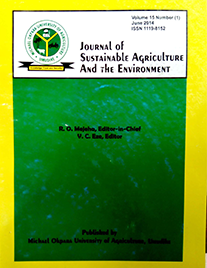Characterization, Classification and Suitability Evaluation of Soils of Eastern Part of Akoko Southwest Local Government Area, Ondo State, Nigeria for Cassava Cultivation.
Main Article Content
Abstract
Soils in the tropics are inherently low in fertility and form the basis on which agricultural production takes place. In order to characterize, classify and evaluate selected soils formed on basement complex for cassava cultivation in eastern part of Akoko Southwest Local Government Area of Ondo State, Nigeria. Six pedons were excavated in the area; pedons 1, 2, 3, 4, 5 and 6 at Ikun 1, Ikun 2, Iwaro, Oka, Akungba, and Ayegunle respectively. Pedons were characterized and classified according to USDA soil Taxonomy and WRB systems of soil classification. The suitability of the study area for cassava cultivation was evaluated by non-parametric and the parametric square methods. Topsoil morphology indicated grayish brown (10YR 5/2) to brown (7YR 5/3) colour matrix, sandy loam to sandy clay loam textures and friable (moist) consistence underlain by yellowish (7.5YR 5/4) to reddish brown (2.5YR 4/3) colour matrix, sandy clay loam to clay textures and firm (moist) consistence endopedon. The distribution of clay content increased with soil depth for all pedons. The soil reaction (in water) was moderately acid to moderately neutral (pH 5.6 to 6.9). Base saturation, percentage organic carbon and total nitrogen were generally low. Pedons 1 was classified as Typic Kandiustult (USDA) with (FAO/WRB) correlation as Kandic Acrisol. Pedon 2 was classified as Plinthic Kandiustult (USDA) and Plinthic Acrisol (FAO/WRB). Pedons 3 and 6 were grouped as Typic Kandiustepts (USDA) and Kandic Cambisols (FAO/WRB). Pedon 4 was classified as Typic Kandiustalf (USDA) and Kandic Luvisol (FAO/WRB) while pedon 5 was Typic Kandiaquept (USDA) and Kandic Cambisol (FAO/WRB). The suitability assessment of the soils by parametric method showed that potentially, 50% of the study area was highly suitable (S1) while remaining 50% was moderately suitable (S2) for cassava cultivation. When assessed by the non-parametric method, the result revealed that the entire area was currently marginally suitable (S3) whereas potentially, 50% was moderately suitable (S2) and the remaining 50% was marginal (S3) for cassava cultivation. The soils require varying levels of fertility management practices targeted at alleviating the identified constraints to cassava productivity.

